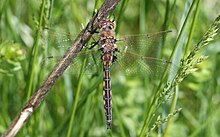Doubts
| Doubts | ||||||||||||
|---|---|---|---|---|---|---|---|---|---|---|---|---|

Double spot ( Epitheca bimaculata ), shortly after the imaginal molt |
||||||||||||
| Systematics | ||||||||||||
|
||||||||||||
| Scientific name | ||||||||||||
| Epitheca | ||||||||||||
| Burmeister , 1839 |
The two-spots ( Epitheca ) are a genus from the family of the falcon dragonflies (Corduliidae). It contains twelve described species, of which only the two-spot ( Epitheca bimaculata ) is native to Europe. Ten species of the genus occur in North America, another in East Asia.
features
Both as larvae and as transformed flying insects ( imagines ), the double spots show only a comparatively low variance in their characteristics, in particular with regard to body size and color.
Characteristics of the adults
The species of the genus belong to the medium-sized falcon dragonflies, with the European two-spot having a wingspan of 8 to 9.5 centimeters. A conspicuous sexual dimorphism does not exist in the species; Sex differences are limited to the formation of the genital appendages on the abdomen and to the shape of the abdomen , which in females is cylindrical due to the ovaries that are inside and filled with eggs and has no constriction, as is the case in males on the third segment of the abdomen.
The species are predominantly brown or black in color and, unlike the emerald dragonflies ( Somatochlora ), have no metallic sheen; A light bronze shimmer can be present at most in the chest area ( thorax ). The thorax is often reddish-brown and has a single color or black stripes. He is also densely hairy, which makes the colors look gloomy. The abdomen is black with brown to yellow spots or stripes; in the case of the European two-spot it is largely orange-brown with a pronounced dark vertical stripe in the middle.
The wings of the double spots are transparent and clear to yellowish in color. They usually have a black basal spot in all species. In the North American species of the genus is usually one, in the Eurasian species two cross veins are formed between the cubital vein and the anal vein and the sectors of the arculus are separated. On the legs of the males there are very well defined tibial keels, which are longest on the hind legs. In contrast to the emerald dragonflies, the abdominal appendages of the males are only slightly differentiated. In the females the subgenital plate is deeply split; it reaches segment S9 or even surpasses it.
Characteristics of the larvae
The larvae are broad, flattened and long-legged. The head is trapezoidal on top and tapers towards the back with rounded corners, in some species there are two conspicuous humps on the top of the head. Their body is hairless and has noticeably long back spines on segments S2 to S9, which are flattened and hook-shaped. There are also strong side spikes on the S8 and S9, the ones on the S9 being three times as long as those on the S8.
Distribution area
The twelve types of double spots are distributed holarctic , so they occur exclusively in the northern hemisphere. Ten of the species are restricted to North America, while the remaining two species live in Eurasia. The only European type of double spot is the European double spot ( E. bimaculata ), whose distribution area extends from Europe to eastern Siberia, northeast China and Japan. The second Eurasian species, E. marginata , lives in Japan, China and the Korean peninsula.
Way of life
The females of the doubles do not lay their eggs individually, but in a coherent, spawn-like gelatinous cord.
Systematics
External system
The double spots are classified as a genus within the falcon dragonflies (Corduliidae) and thus in the Libelluloidea . A total of 39 genera are currently distinguished within this family, although the monophyly of the falcon dragonflies in relation to the sail dragonflies (Libellulidae) has been questioned by several authors. This applies in particular to the genus Macromia and some associated genera, which have been separated out by some authors as a separate family Macromiidae, as well as the genus group around the river hawk ( Oxygastra ) and a number of other genera, which are considered to be sister groups to all the remaining dragonflies and the sail dragonflies .
Relationship of the falcon and sail dragonflies according to Ware et al. 2007:
| Libelluloidea |
|
||||||||||||||||||
|
|
Within the falcon dragonflies, the two-spots are combined with some genera (including Cordulia and Somatochlora ) to form the Corduliinae (or Corduliidae sensu stricto), which are considered monophyletic. No information is available on the monophyly of the genus itself, but it is also not in doubt. The sister group is not clearly identified.
Internal system
A total of 12 described species are summarized within the two spots.
- European two-spot , Epitheca bimaculata (Charpentier, 1825)
- Epitheca canis (McLachlan, 1886)
- Epitheca costalis (Selys, 1871)
- Epitheca cynosura (Say, 1840)
- Epitheca marginata (Selys, 1883)
- Epitheca petechialis (Muttkowski, 1911)
- Epitheca princeps Hagen, 1861
- Epitheca semiaquea (Burmeister, 1839)
- Epitheca sepia (Gloyd, 1933)
- Epitheca spinigera (Selys, 1871)
- Epitheca spinosa (Hagen in Selys, 1878)
- Epitheca stella (Williamson in Muttkowski, 1911)
supporting documents
- ↑ Development in the ovary: from the oogonium to the egg. In: Hansruedie Wildermuth: The falcon dragonflies in Europe. Pp. 46-47.
- ↑ a b c d e f g genus Epitheca BURMEISTER. In: Hansruedie Wildermuth: The falcon dragonflies in Europe. Pp. 336-3338.
- ↑ a b Martin Schorr, Martin Lindeboom, Dennis Paulson: World Odonata List. Update from October 2, 2011 ( download ).
- ↑ a b c Jessica Ware, Michael May, Karl Kjer: Phylogeny of the higher Libelluloidea (Anisoptera: Odonata): An exploration of the most speciose superfamily of dragonflies. Molecular Phylogenetics and Evolution 45 (1), 2007; Pp. 289-310.
literature
- Hansruedie Wildermuth: Europe's falcon dragonflies . Neue Brehm-Bücherei Volume 653, Westarp Sciences Hohenwarsleben 2008; Pp. 336-338. ISBN 978-3-89432-896-2 .

